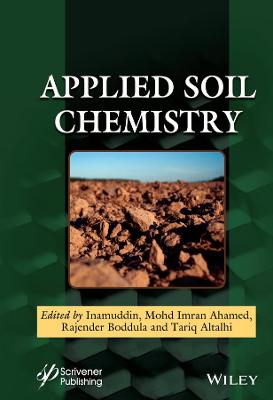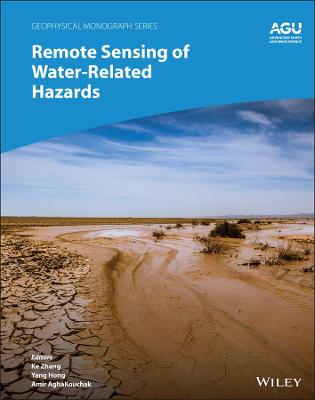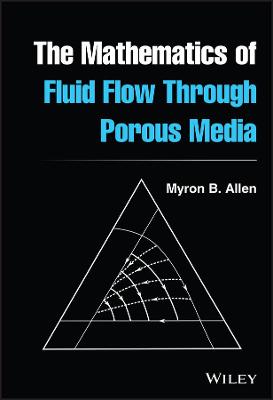Applied Soil Chemistry
 -15%
portes grátis
-15%
portes grátis
Applied Soil Chemistry
Altalhi, Tariq; Ahamed, Mohd Imran; Inamuddin; Boddula, Rajender
John Wiley & Sons Inc
04/2021
288
Dura
Inglês
9781119710189
15 a 20 dias
522
Descrição não disponível.
Preface xiii
1 Potential and Challenges of Carbon Sequestration in Soils 1
Erfan Sadatshojaei, David A. Wood and Mohammad Reza Rahimpour
List of Abbreviations and Units 2
1.1 Introduction 2
1.1.1 Soil Decomposition Processes 4
1.1.2 Organic Compounds Present in Soils 6
1.1.3 Cycle Time of Carbon in Soils 7
1.2 Influences Impacting Carbon Stabilization Rates in Soils 8
1.2.1 Weather Conditions and Fluctuations 9
1.2.2 Plant and Natural Biomass Inputs 11
1.2.3 Organic Enrichment Treatments 11
1.2.4 Tilled and Ploughed Agricultural Land 11
1.2.5 Pasture Managed for Livestock Grazing 12
1.2.6 Irrigated Arable Lands and Their Associated Drainage 12
1.2.7 Uncertain Impacts of Soil Erosion and Redistribution on Its Carbon Store 13
1.2.8 Fire Impacts on Soil Characteristics 13
1.3 Carbon-Sequestration Potential of Specific Vegetation Zones and Ecosystems 14
1.3.1 Croplands 14
1.3.2 Grasslands 15
1.3.3 Woodlands 16
1.3.4 Temperate Wetlands and Peat Bogs 16
1.3.5 Induced Changes in Vegetation and Land Conditions 16
1.3.6 Warm Temperate and Tropical Vegetated Zones 17
1.4 Estimates of Global Potential for Carbon Sequestration in Soils 17
1.5 Conclusions 18
References 18
2 A Brief Insight on Factors Controlling Rate of Chemical Weathering of Minerals Existing in Soil 23
Tejaswini Sahoo, Rashmirekha Tripathy, Jagannath Panda, Madhuri Hembram, Saraswati Soren, Deepak Kumar Senapati, C.K. Rath, Sunil Kumar Sahoo and Rojalin Sahu
2.1 Introduction 23
2.1.1 Weathering Similar to Hydrothermal and Diuretic Alteration of Minerals 25
2.2 Comparitive Stability of Minerals on the Basis of Their Sequence of Weathering 26
2.2.1 Heavy Minerals 26
2.2.2 Coarsely Grinded Minerals 27
2.2.3 Clay Size Mineral Particles 27
2.3 Factors Affecting the Rate of Chemical Weathering 28
2.3.1 Capacity Factors Which Controls the Reaction Rate of Chemical Weathering 28
2.3.1.1 Specific Surface Role 28
2.3.1.2 Specific Weatherability Role of Mineral 29
2.3.2 Intensity Factors Which Drives the Chemical Weathering Reaction Rate 29
2.3.2.1 Factor of Temperature 29
2.3.2.2 Leaching and Water Contribution 30
2.3.2.3 Acidity Factor 31
2.3.2.4 Biotic Processes Factor 31
2.3.2.5 Reduction and Oxidation Factor 32
2.3.2.6 Influence of Time on the Rate of Chemical Weathering 33
2.4 Conclusion 34
References 34
3 Agroecosystems and Bioeconomy 41
Paolo Di Sia
3.1 Introduction 42
3.2 Problems Related to Agricultural Intensification 43
3.3 Important Themes and Indicators 46
3.4 The Bioeconomy 48
3.5 On Circular Bioeconomy 49
3.6 Bioeconomy, Environment, and Natural Capital 50
3.7 The Bioeconomy in Daily Life 52
3.8 Conclusions 54
References 56
4 Technological Advances in Analyzing of Soil Chemistry 61
M. Ramesh and L. Rajeshkumar
4.1 Introduction 61
4.2 Soil Chemistry 62
4.2.1 Advances in Time-Resolved Molecular Scale Techniques 64
4.2.2 Carbon Speciation in Soils 66
4.2.3 Soil Analysis Using Sensors 68
4.2.4 Soil Analysis Using AI 68
4.2.5 Soil Analysis Using ML 69
4.2.6 Soil Analysis Using IoT 69
4.2.7 Soil Analysis Using Big Data 71
4.2.8 Soil Analysis Using Drone and/or Satellite 73
4.3 Conclusion 74
References 75
5 An Overview of Soil Chemistry and Role of Its Components in Sorption of Heavy Metals in Soil 79
Shagufta Jabin, Jamal A. Khan and Sapana Jadoun
5.1 Introduction 80
5.2 Composition of Soil 80
5.2.1 Solid Phase 81
5.2.1.1 Soil Inorganic Matters 81
5.2.1.2 Soil Organic Matter 85
5.2.2 Liquid Phase 86
5.2.3 Gaseous Phase 88
5.3 Soil Characterization 89
5.3.1 Structure 89
5.3.2 Color 91
5.3.3 Texture 91
5.3.4 Bulk Density 92
5.3.5 Particle Size Distribution 92
5.4 Physico-Chemical Properties of Soil 92
5.4.1 Soil pH 93
5.4.2 Soil Temperature 93
5.4.3 Electrical Conductivity 93
5.4.4 Cation Exchange Capacity 94
5.5 Sorption Behavior of Soil 94
5.6 Conclusion 97
References 97
6 Soil and Their Contaminants 105
Anupama Rajput
6.1 Introduction 105
6.1.1 Component of Soil 105
6.1.2 Major Types of Soil in India 107
6.1.3 The Various Factors Occurs in Soil Formation 107
6.1.4 Types of Soil Textures 107
6.1.4.1 Clayer Soils 107
6.1.4.2 Sandy Soils 109
6.1.4.3 Slit Soils 109
6.2 Soil Organic Matter (SOM) 109
6.2.1 Soil Chemical Reaction 110
6.2.2 Sality and Acidity 110
6.3 Contaminants in Soil 111
6.3.1 Pesticides 112
6.3.2 Some of the Adverse Effects of Pesticides 112
6.4 Pollution of Soil 112
6.4.1 Effects of Modern Agriculture 113
6.4.2 Effects of Chemicals 113
6.5 Chemistry of Saline Soil 115
6.6 The Effect of Salinity in Plant Growth 117
6.7 Conclusion 118
References 118
7 Fertilization and Fertilizer Types 123
Idris Karagoez
7.1 Introduction 124
7.2 The Purpose and Application Methods of Fertilization 125
7.3 Classification of Fertilizers 131
7.4 Fertilizers Containing Organic Matters 132
7.4.1 Herbal and Animal-Based Fertilizers 132
7.4.2 Organomineral Fertilizers 134
7.4.3 Soil Conditioners 135
7.5 Chemical Fertilizers 136
7.5.1 Solid and Liquid Fertilizers With Inorganic Primary Single and Compound Plant Nutrients 137
7.5.2 Fertilizers With Inorganic Secondary Nutrients 142
7.5.3 Fertilizers With Micro Plant Nutrients 143
7.6 Conclusion and Evaluation 145
References 145
8 Heavy Metal Chemistry in Soils 149
Sapna Nehra, Rekha Sharma and Dinesh Kumar
8.1 Introduction 149
8.2 Outline of the Heavy Metal Chemistry in Soil 151
8.3 Conclusions 158
8.4 Abbreviations 159
Acknowledgment 160
References 160
9 Modeling of Pollutant Mobility in Soil 165
Juelide Hizal
9.1 Introduction 165
9.2 Modeling of Heavy Metal Sorption onto Soil or Soil Components 166
9.3 Modeling of Sorption of Other Pollutants onto Soil or Soil Components 177
9.4 Conclusion 178
References 179
10 Soil Chemistry: Composition and Laws 183
Manju Yadav and Dinesh Kumar
10.1 Introduction 183
10.2 The Materials With Which Nutrients React 184
10.2.1 The Clay Minerals 185
10.2.2 Variable-Charge Mineral Surfaces 186
10.2.3 Organic Matter 188
10.3 Soil Chemistry: Laws 189
10.3.1 First Law 189
10.3.2 Second Law 190
10.3.3 Third Rule 192
Acknowledgments 194
References 194
11 Parameters of Soil Chemistry 197
Manju Yadav and Dinesh Kumar
11.1 Introduction 197
11.1.2 Soil Morphology 199
11.1.3 Basic Soil Components 199
11.1.3.1 Mineral 200
11.1.3.2 Water 200
11.1.3.3 Organic Matter 201
11.1.3.4 Gases 201
11.1.3.5 Microorganisms 202
11.2 Concepts of Soil Chemistry 202
11.2.1 Soil Aeration 203
11.2.2 Soil Colloid 204
11.2.3 Soil Water 204
11.2.4 Ion Exchange Property 206
11.2.4.1 Cation Exchange Capacity (CEC) 206
11.2.4.2 Anion Exchange Capacity (AEC) 207
11.2.5 Soil pH-Acidity and Alkalinity 208
11.2.5.1 Acid Soil Formation 209
11.2.5.2 Acid Soil Benefits 210
11.2.5.3 Liming-Decreasing Soil Acidity 211
11.2.5.4 Alkaline Soil Formation 211
Acknowledgments 212
References 212
12 Essential Soil Functions for Enhanced Agricultural Productivity and Food Production 215
Charles Oluwaseun Adetunji and Osayomwanbo Osarenotor
12.1 Introduction 216
12.2 Effect of Pesticides on Soil Function Indicator 216
12.3 Soil Organic Matter 219
12.4 Soil Organic Carbon 220
12.4.1 Relationship Between Global Carbon Cycle and Soil Carbon as a Typical Example of Soil Function 221
12.4.2 Relationship Between CO2 Levels in the Atmosphere and Soil Carbon Content 222
12.4.3 Relationship Between Soil Organic Content and Soil Carbon Sequestration 222
12.4.4 Essential Soil Biological Processes and Their Relationship With Soil pH 224
12.4.4.1 Microbial Ecophysiological Indicators 224
12.4.5 Soil Enzyme Activities and Their Relationship With Soil pH 225
12.4.6 Biodegradation of Toxic Substances by Soil Microorganisms and Their Relationship With Soil pH 225
12.4.6.1 Water Holding Capacity 226
12.4.6.2 Soil Erodibility 226
12.4.6.3 Nutrient Cycling 226
12.5 Conclusion and Future Recommendation to Knowledge 227
References 228
13 Role of Pesticide Applications in Sustainable Agriculture 235
Osikemekha Anthony Anani and Charles Oluwaseun Adetunji
13.1 Introduction 235
13.2 Various Types of Pesticides and Their Application in Agriculture 237
13.3 Modes of Action of Pesticides 241
13.3.1 Organochlorine Pesticides 245
13.3.2 Organophosphorus Pesticides 245
13.3.4 Carbamate Pesticides 246
13.3.5 Other Classes of Chemical Pesticides 247
13.4 Conclusion and Recommendation to Knowledge 247
References 248
Index 257
1 Potential and Challenges of Carbon Sequestration in Soils 1
Erfan Sadatshojaei, David A. Wood and Mohammad Reza Rahimpour
List of Abbreviations and Units 2
1.1 Introduction 2
1.1.1 Soil Decomposition Processes 4
1.1.2 Organic Compounds Present in Soils 6
1.1.3 Cycle Time of Carbon in Soils 7
1.2 Influences Impacting Carbon Stabilization Rates in Soils 8
1.2.1 Weather Conditions and Fluctuations 9
1.2.2 Plant and Natural Biomass Inputs 11
1.2.3 Organic Enrichment Treatments 11
1.2.4 Tilled and Ploughed Agricultural Land 11
1.2.5 Pasture Managed for Livestock Grazing 12
1.2.6 Irrigated Arable Lands and Their Associated Drainage 12
1.2.7 Uncertain Impacts of Soil Erosion and Redistribution on Its Carbon Store 13
1.2.8 Fire Impacts on Soil Characteristics 13
1.3 Carbon-Sequestration Potential of Specific Vegetation Zones and Ecosystems 14
1.3.1 Croplands 14
1.3.2 Grasslands 15
1.3.3 Woodlands 16
1.3.4 Temperate Wetlands and Peat Bogs 16
1.3.5 Induced Changes in Vegetation and Land Conditions 16
1.3.6 Warm Temperate and Tropical Vegetated Zones 17
1.4 Estimates of Global Potential for Carbon Sequestration in Soils 17
1.5 Conclusions 18
References 18
2 A Brief Insight on Factors Controlling Rate of Chemical Weathering of Minerals Existing in Soil 23
Tejaswini Sahoo, Rashmirekha Tripathy, Jagannath Panda, Madhuri Hembram, Saraswati Soren, Deepak Kumar Senapati, C.K. Rath, Sunil Kumar Sahoo and Rojalin Sahu
2.1 Introduction 23
2.1.1 Weathering Similar to Hydrothermal and Diuretic Alteration of Minerals 25
2.2 Comparitive Stability of Minerals on the Basis of Their Sequence of Weathering 26
2.2.1 Heavy Minerals 26
2.2.2 Coarsely Grinded Minerals 27
2.2.3 Clay Size Mineral Particles 27
2.3 Factors Affecting the Rate of Chemical Weathering 28
2.3.1 Capacity Factors Which Controls the Reaction Rate of Chemical Weathering 28
2.3.1.1 Specific Surface Role 28
2.3.1.2 Specific Weatherability Role of Mineral 29
2.3.2 Intensity Factors Which Drives the Chemical Weathering Reaction Rate 29
2.3.2.1 Factor of Temperature 29
2.3.2.2 Leaching and Water Contribution 30
2.3.2.3 Acidity Factor 31
2.3.2.4 Biotic Processes Factor 31
2.3.2.5 Reduction and Oxidation Factor 32
2.3.2.6 Influence of Time on the Rate of Chemical Weathering 33
2.4 Conclusion 34
References 34
3 Agroecosystems and Bioeconomy 41
Paolo Di Sia
3.1 Introduction 42
3.2 Problems Related to Agricultural Intensification 43
3.3 Important Themes and Indicators 46
3.4 The Bioeconomy 48
3.5 On Circular Bioeconomy 49
3.6 Bioeconomy, Environment, and Natural Capital 50
3.7 The Bioeconomy in Daily Life 52
3.8 Conclusions 54
References 56
4 Technological Advances in Analyzing of Soil Chemistry 61
M. Ramesh and L. Rajeshkumar
4.1 Introduction 61
4.2 Soil Chemistry 62
4.2.1 Advances in Time-Resolved Molecular Scale Techniques 64
4.2.2 Carbon Speciation in Soils 66
4.2.3 Soil Analysis Using Sensors 68
4.2.4 Soil Analysis Using AI 68
4.2.5 Soil Analysis Using ML 69
4.2.6 Soil Analysis Using IoT 69
4.2.7 Soil Analysis Using Big Data 71
4.2.8 Soil Analysis Using Drone and/or Satellite 73
4.3 Conclusion 74
References 75
5 An Overview of Soil Chemistry and Role of Its Components in Sorption of Heavy Metals in Soil 79
Shagufta Jabin, Jamal A. Khan and Sapana Jadoun
5.1 Introduction 80
5.2 Composition of Soil 80
5.2.1 Solid Phase 81
5.2.1.1 Soil Inorganic Matters 81
5.2.1.2 Soil Organic Matter 85
5.2.2 Liquid Phase 86
5.2.3 Gaseous Phase 88
5.3 Soil Characterization 89
5.3.1 Structure 89
5.3.2 Color 91
5.3.3 Texture 91
5.3.4 Bulk Density 92
5.3.5 Particle Size Distribution 92
5.4 Physico-Chemical Properties of Soil 92
5.4.1 Soil pH 93
5.4.2 Soil Temperature 93
5.4.3 Electrical Conductivity 93
5.4.4 Cation Exchange Capacity 94
5.5 Sorption Behavior of Soil 94
5.6 Conclusion 97
References 97
6 Soil and Their Contaminants 105
Anupama Rajput
6.1 Introduction 105
6.1.1 Component of Soil 105
6.1.2 Major Types of Soil in India 107
6.1.3 The Various Factors Occurs in Soil Formation 107
6.1.4 Types of Soil Textures 107
6.1.4.1 Clayer Soils 107
6.1.4.2 Sandy Soils 109
6.1.4.3 Slit Soils 109
6.2 Soil Organic Matter (SOM) 109
6.2.1 Soil Chemical Reaction 110
6.2.2 Sality and Acidity 110
6.3 Contaminants in Soil 111
6.3.1 Pesticides 112
6.3.2 Some of the Adverse Effects of Pesticides 112
6.4 Pollution of Soil 112
6.4.1 Effects of Modern Agriculture 113
6.4.2 Effects of Chemicals 113
6.5 Chemistry of Saline Soil 115
6.6 The Effect of Salinity in Plant Growth 117
6.7 Conclusion 118
References 118
7 Fertilization and Fertilizer Types 123
Idris Karagoez
7.1 Introduction 124
7.2 The Purpose and Application Methods of Fertilization 125
7.3 Classification of Fertilizers 131
7.4 Fertilizers Containing Organic Matters 132
7.4.1 Herbal and Animal-Based Fertilizers 132
7.4.2 Organomineral Fertilizers 134
7.4.3 Soil Conditioners 135
7.5 Chemical Fertilizers 136
7.5.1 Solid and Liquid Fertilizers With Inorganic Primary Single and Compound Plant Nutrients 137
7.5.2 Fertilizers With Inorganic Secondary Nutrients 142
7.5.3 Fertilizers With Micro Plant Nutrients 143
7.6 Conclusion and Evaluation 145
References 145
8 Heavy Metal Chemistry in Soils 149
Sapna Nehra, Rekha Sharma and Dinesh Kumar
8.1 Introduction 149
8.2 Outline of the Heavy Metal Chemistry in Soil 151
8.3 Conclusions 158
8.4 Abbreviations 159
Acknowledgment 160
References 160
9 Modeling of Pollutant Mobility in Soil 165
Juelide Hizal
9.1 Introduction 165
9.2 Modeling of Heavy Metal Sorption onto Soil or Soil Components 166
9.3 Modeling of Sorption of Other Pollutants onto Soil or Soil Components 177
9.4 Conclusion 178
References 179
10 Soil Chemistry: Composition and Laws 183
Manju Yadav and Dinesh Kumar
10.1 Introduction 183
10.2 The Materials With Which Nutrients React 184
10.2.1 The Clay Minerals 185
10.2.2 Variable-Charge Mineral Surfaces 186
10.2.3 Organic Matter 188
10.3 Soil Chemistry: Laws 189
10.3.1 First Law 189
10.3.2 Second Law 190
10.3.3 Third Rule 192
Acknowledgments 194
References 194
11 Parameters of Soil Chemistry 197
Manju Yadav and Dinesh Kumar
11.1 Introduction 197
11.1.2 Soil Morphology 199
11.1.3 Basic Soil Components 199
11.1.3.1 Mineral 200
11.1.3.2 Water 200
11.1.3.3 Organic Matter 201
11.1.3.4 Gases 201
11.1.3.5 Microorganisms 202
11.2 Concepts of Soil Chemistry 202
11.2.1 Soil Aeration 203
11.2.2 Soil Colloid 204
11.2.3 Soil Water 204
11.2.4 Ion Exchange Property 206
11.2.4.1 Cation Exchange Capacity (CEC) 206
11.2.4.2 Anion Exchange Capacity (AEC) 207
11.2.5 Soil pH-Acidity and Alkalinity 208
11.2.5.1 Acid Soil Formation 209
11.2.5.2 Acid Soil Benefits 210
11.2.5.3 Liming-Decreasing Soil Acidity 211
11.2.5.4 Alkaline Soil Formation 211
Acknowledgments 212
References 212
12 Essential Soil Functions for Enhanced Agricultural Productivity and Food Production 215
Charles Oluwaseun Adetunji and Osayomwanbo Osarenotor
12.1 Introduction 216
12.2 Effect of Pesticides on Soil Function Indicator 216
12.3 Soil Organic Matter 219
12.4 Soil Organic Carbon 220
12.4.1 Relationship Between Global Carbon Cycle and Soil Carbon as a Typical Example of Soil Function 221
12.4.2 Relationship Between CO2 Levels in the Atmosphere and Soil Carbon Content 222
12.4.3 Relationship Between Soil Organic Content and Soil Carbon Sequestration 222
12.4.4 Essential Soil Biological Processes and Their Relationship With Soil pH 224
12.4.4.1 Microbial Ecophysiological Indicators 224
12.4.5 Soil Enzyme Activities and Their Relationship With Soil pH 225
12.4.6 Biodegradation of Toxic Substances by Soil Microorganisms and Their Relationship With Soil pH 225
12.4.6.1 Water Holding Capacity 226
12.4.6.2 Soil Erodibility 226
12.4.6.3 Nutrient Cycling 226
12.5 Conclusion and Future Recommendation to Knowledge 227
References 228
13 Role of Pesticide Applications in Sustainable Agriculture 235
Osikemekha Anthony Anani and Charles Oluwaseun Adetunji
13.1 Introduction 235
13.2 Various Types of Pesticides and Their Application in Agriculture 237
13.3 Modes of Action of Pesticides 241
13.3.1 Organochlorine Pesticides 245
13.3.2 Organophosphorus Pesticides 245
13.3.4 Carbamate Pesticides 246
13.3.5 Other Classes of Chemical Pesticides 247
13.4 Conclusion and Recommendation to Knowledge 247
References 248
Index 257
Este título pertence ao(s) assunto(s) indicados(s). Para ver outros títulos clique no assunto desejado.
Soil chemistry handbook; soil chemistry textbook; soil science; soil science fundamentals; applied soil sciences; soil chemical reactions; soil functions; soil chemical recycling; soil chemical weathering; carbon sequestration; environmental soil
Preface xiii
1 Potential and Challenges of Carbon Sequestration in Soils 1
Erfan Sadatshojaei, David A. Wood and Mohammad Reza Rahimpour
List of Abbreviations and Units 2
1.1 Introduction 2
1.1.1 Soil Decomposition Processes 4
1.1.2 Organic Compounds Present in Soils 6
1.1.3 Cycle Time of Carbon in Soils 7
1.2 Influences Impacting Carbon Stabilization Rates in Soils 8
1.2.1 Weather Conditions and Fluctuations 9
1.2.2 Plant and Natural Biomass Inputs 11
1.2.3 Organic Enrichment Treatments 11
1.2.4 Tilled and Ploughed Agricultural Land 11
1.2.5 Pasture Managed for Livestock Grazing 12
1.2.6 Irrigated Arable Lands and Their Associated Drainage 12
1.2.7 Uncertain Impacts of Soil Erosion and Redistribution on Its Carbon Store 13
1.2.8 Fire Impacts on Soil Characteristics 13
1.3 Carbon-Sequestration Potential of Specific Vegetation Zones and Ecosystems 14
1.3.1 Croplands 14
1.3.2 Grasslands 15
1.3.3 Woodlands 16
1.3.4 Temperate Wetlands and Peat Bogs 16
1.3.5 Induced Changes in Vegetation and Land Conditions 16
1.3.6 Warm Temperate and Tropical Vegetated Zones 17
1.4 Estimates of Global Potential for Carbon Sequestration in Soils 17
1.5 Conclusions 18
References 18
2 A Brief Insight on Factors Controlling Rate of Chemical Weathering of Minerals Existing in Soil 23
Tejaswini Sahoo, Rashmirekha Tripathy, Jagannath Panda, Madhuri Hembram, Saraswati Soren, Deepak Kumar Senapati, C.K. Rath, Sunil Kumar Sahoo and Rojalin Sahu
2.1 Introduction 23
2.1.1 Weathering Similar to Hydrothermal and Diuretic Alteration of Minerals 25
2.2 Comparitive Stability of Minerals on the Basis of Their Sequence of Weathering 26
2.2.1 Heavy Minerals 26
2.2.2 Coarsely Grinded Minerals 27
2.2.3 Clay Size Mineral Particles 27
2.3 Factors Affecting the Rate of Chemical Weathering 28
2.3.1 Capacity Factors Which Controls the Reaction Rate of Chemical Weathering 28
2.3.1.1 Specific Surface Role 28
2.3.1.2 Specific Weatherability Role of Mineral 29
2.3.2 Intensity Factors Which Drives the Chemical Weathering Reaction Rate 29
2.3.2.1 Factor of Temperature 29
2.3.2.2 Leaching and Water Contribution 30
2.3.2.3 Acidity Factor 31
2.3.2.4 Biotic Processes Factor 31
2.3.2.5 Reduction and Oxidation Factor 32
2.3.2.6 Influence of Time on the Rate of Chemical Weathering 33
2.4 Conclusion 34
References 34
3 Agroecosystems and Bioeconomy 41
Paolo Di Sia
3.1 Introduction 42
3.2 Problems Related to Agricultural Intensification 43
3.3 Important Themes and Indicators 46
3.4 The Bioeconomy 48
3.5 On Circular Bioeconomy 49
3.6 Bioeconomy, Environment, and Natural Capital 50
3.7 The Bioeconomy in Daily Life 52
3.8 Conclusions 54
References 56
4 Technological Advances in Analyzing of Soil Chemistry 61
M. Ramesh and L. Rajeshkumar
4.1 Introduction 61
4.2 Soil Chemistry 62
4.2.1 Advances in Time-Resolved Molecular Scale Techniques 64
4.2.2 Carbon Speciation in Soils 66
4.2.3 Soil Analysis Using Sensors 68
4.2.4 Soil Analysis Using AI 68
4.2.5 Soil Analysis Using ML 69
4.2.6 Soil Analysis Using IoT 69
4.2.7 Soil Analysis Using Big Data 71
4.2.8 Soil Analysis Using Drone and/or Satellite 73
4.3 Conclusion 74
References 75
5 An Overview of Soil Chemistry and Role of Its Components in Sorption of Heavy Metals in Soil 79
Shagufta Jabin, Jamal A. Khan and Sapana Jadoun
5.1 Introduction 80
5.2 Composition of Soil 80
5.2.1 Solid Phase 81
5.2.1.1 Soil Inorganic Matters 81
5.2.1.2 Soil Organic Matter 85
5.2.2 Liquid Phase 86
5.2.3 Gaseous Phase 88
5.3 Soil Characterization 89
5.3.1 Structure 89
5.3.2 Color 91
5.3.3 Texture 91
5.3.4 Bulk Density 92
5.3.5 Particle Size Distribution 92
5.4 Physico-Chemical Properties of Soil 92
5.4.1 Soil pH 93
5.4.2 Soil Temperature 93
5.4.3 Electrical Conductivity 93
5.4.4 Cation Exchange Capacity 94
5.5 Sorption Behavior of Soil 94
5.6 Conclusion 97
References 97
6 Soil and Their Contaminants 105
Anupama Rajput
6.1 Introduction 105
6.1.1 Component of Soil 105
6.1.2 Major Types of Soil in India 107
6.1.3 The Various Factors Occurs in Soil Formation 107
6.1.4 Types of Soil Textures 107
6.1.4.1 Clayer Soils 107
6.1.4.2 Sandy Soils 109
6.1.4.3 Slit Soils 109
6.2 Soil Organic Matter (SOM) 109
6.2.1 Soil Chemical Reaction 110
6.2.2 Sality and Acidity 110
6.3 Contaminants in Soil 111
6.3.1 Pesticides 112
6.3.2 Some of the Adverse Effects of Pesticides 112
6.4 Pollution of Soil 112
6.4.1 Effects of Modern Agriculture 113
6.4.2 Effects of Chemicals 113
6.5 Chemistry of Saline Soil 115
6.6 The Effect of Salinity in Plant Growth 117
6.7 Conclusion 118
References 118
7 Fertilization and Fertilizer Types 123
Idris Karagoez
7.1 Introduction 124
7.2 The Purpose and Application Methods of Fertilization 125
7.3 Classification of Fertilizers 131
7.4 Fertilizers Containing Organic Matters 132
7.4.1 Herbal and Animal-Based Fertilizers 132
7.4.2 Organomineral Fertilizers 134
7.4.3 Soil Conditioners 135
7.5 Chemical Fertilizers 136
7.5.1 Solid and Liquid Fertilizers With Inorganic Primary Single and Compound Plant Nutrients 137
7.5.2 Fertilizers With Inorganic Secondary Nutrients 142
7.5.3 Fertilizers With Micro Plant Nutrients 143
7.6 Conclusion and Evaluation 145
References 145
8 Heavy Metal Chemistry in Soils 149
Sapna Nehra, Rekha Sharma and Dinesh Kumar
8.1 Introduction 149
8.2 Outline of the Heavy Metal Chemistry in Soil 151
8.3 Conclusions 158
8.4 Abbreviations 159
Acknowledgment 160
References 160
9 Modeling of Pollutant Mobility in Soil 165
Juelide Hizal
9.1 Introduction 165
9.2 Modeling of Heavy Metal Sorption onto Soil or Soil Components 166
9.3 Modeling of Sorption of Other Pollutants onto Soil or Soil Components 177
9.4 Conclusion 178
References 179
10 Soil Chemistry: Composition and Laws 183
Manju Yadav and Dinesh Kumar
10.1 Introduction 183
10.2 The Materials With Which Nutrients React 184
10.2.1 The Clay Minerals 185
10.2.2 Variable-Charge Mineral Surfaces 186
10.2.3 Organic Matter 188
10.3 Soil Chemistry: Laws 189
10.3.1 First Law 189
10.3.2 Second Law 190
10.3.3 Third Rule 192
Acknowledgments 194
References 194
11 Parameters of Soil Chemistry 197
Manju Yadav and Dinesh Kumar
11.1 Introduction 197
11.1.2 Soil Morphology 199
11.1.3 Basic Soil Components 199
11.1.3.1 Mineral 200
11.1.3.2 Water 200
11.1.3.3 Organic Matter 201
11.1.3.4 Gases 201
11.1.3.5 Microorganisms 202
11.2 Concepts of Soil Chemistry 202
11.2.1 Soil Aeration 203
11.2.2 Soil Colloid 204
11.2.3 Soil Water 204
11.2.4 Ion Exchange Property 206
11.2.4.1 Cation Exchange Capacity (CEC) 206
11.2.4.2 Anion Exchange Capacity (AEC) 207
11.2.5 Soil pH-Acidity and Alkalinity 208
11.2.5.1 Acid Soil Formation 209
11.2.5.2 Acid Soil Benefits 210
11.2.5.3 Liming-Decreasing Soil Acidity 211
11.2.5.4 Alkaline Soil Formation 211
Acknowledgments 212
References 212
12 Essential Soil Functions for Enhanced Agricultural Productivity and Food Production 215
Charles Oluwaseun Adetunji and Osayomwanbo Osarenotor
12.1 Introduction 216
12.2 Effect of Pesticides on Soil Function Indicator 216
12.3 Soil Organic Matter 219
12.4 Soil Organic Carbon 220
12.4.1 Relationship Between Global Carbon Cycle and Soil Carbon as a Typical Example of Soil Function 221
12.4.2 Relationship Between CO2 Levels in the Atmosphere and Soil Carbon Content 222
12.4.3 Relationship Between Soil Organic Content and Soil Carbon Sequestration 222
12.4.4 Essential Soil Biological Processes and Their Relationship With Soil pH 224
12.4.4.1 Microbial Ecophysiological Indicators 224
12.4.5 Soil Enzyme Activities and Their Relationship With Soil pH 225
12.4.6 Biodegradation of Toxic Substances by Soil Microorganisms and Their Relationship With Soil pH 225
12.4.6.1 Water Holding Capacity 226
12.4.6.2 Soil Erodibility 226
12.4.6.3 Nutrient Cycling 226
12.5 Conclusion and Future Recommendation to Knowledge 227
References 228
13 Role of Pesticide Applications in Sustainable Agriculture 235
Osikemekha Anthony Anani and Charles Oluwaseun Adetunji
13.1 Introduction 235
13.2 Various Types of Pesticides and Their Application in Agriculture 237
13.3 Modes of Action of Pesticides 241
13.3.1 Organochlorine Pesticides 245
13.3.2 Organophosphorus Pesticides 245
13.3.4 Carbamate Pesticides 246
13.3.5 Other Classes of Chemical Pesticides 247
13.4 Conclusion and Recommendation to Knowledge 247
References 248
Index 257
1 Potential and Challenges of Carbon Sequestration in Soils 1
Erfan Sadatshojaei, David A. Wood and Mohammad Reza Rahimpour
List of Abbreviations and Units 2
1.1 Introduction 2
1.1.1 Soil Decomposition Processes 4
1.1.2 Organic Compounds Present in Soils 6
1.1.3 Cycle Time of Carbon in Soils 7
1.2 Influences Impacting Carbon Stabilization Rates in Soils 8
1.2.1 Weather Conditions and Fluctuations 9
1.2.2 Plant and Natural Biomass Inputs 11
1.2.3 Organic Enrichment Treatments 11
1.2.4 Tilled and Ploughed Agricultural Land 11
1.2.5 Pasture Managed for Livestock Grazing 12
1.2.6 Irrigated Arable Lands and Their Associated Drainage 12
1.2.7 Uncertain Impacts of Soil Erosion and Redistribution on Its Carbon Store 13
1.2.8 Fire Impacts on Soil Characteristics 13
1.3 Carbon-Sequestration Potential of Specific Vegetation Zones and Ecosystems 14
1.3.1 Croplands 14
1.3.2 Grasslands 15
1.3.3 Woodlands 16
1.3.4 Temperate Wetlands and Peat Bogs 16
1.3.5 Induced Changes in Vegetation and Land Conditions 16
1.3.6 Warm Temperate and Tropical Vegetated Zones 17
1.4 Estimates of Global Potential for Carbon Sequestration in Soils 17
1.5 Conclusions 18
References 18
2 A Brief Insight on Factors Controlling Rate of Chemical Weathering of Minerals Existing in Soil 23
Tejaswini Sahoo, Rashmirekha Tripathy, Jagannath Panda, Madhuri Hembram, Saraswati Soren, Deepak Kumar Senapati, C.K. Rath, Sunil Kumar Sahoo and Rojalin Sahu
2.1 Introduction 23
2.1.1 Weathering Similar to Hydrothermal and Diuretic Alteration of Minerals 25
2.2 Comparitive Stability of Minerals on the Basis of Their Sequence of Weathering 26
2.2.1 Heavy Minerals 26
2.2.2 Coarsely Grinded Minerals 27
2.2.3 Clay Size Mineral Particles 27
2.3 Factors Affecting the Rate of Chemical Weathering 28
2.3.1 Capacity Factors Which Controls the Reaction Rate of Chemical Weathering 28
2.3.1.1 Specific Surface Role 28
2.3.1.2 Specific Weatherability Role of Mineral 29
2.3.2 Intensity Factors Which Drives the Chemical Weathering Reaction Rate 29
2.3.2.1 Factor of Temperature 29
2.3.2.2 Leaching and Water Contribution 30
2.3.2.3 Acidity Factor 31
2.3.2.4 Biotic Processes Factor 31
2.3.2.5 Reduction and Oxidation Factor 32
2.3.2.6 Influence of Time on the Rate of Chemical Weathering 33
2.4 Conclusion 34
References 34
3 Agroecosystems and Bioeconomy 41
Paolo Di Sia
3.1 Introduction 42
3.2 Problems Related to Agricultural Intensification 43
3.3 Important Themes and Indicators 46
3.4 The Bioeconomy 48
3.5 On Circular Bioeconomy 49
3.6 Bioeconomy, Environment, and Natural Capital 50
3.7 The Bioeconomy in Daily Life 52
3.8 Conclusions 54
References 56
4 Technological Advances in Analyzing of Soil Chemistry 61
M. Ramesh and L. Rajeshkumar
4.1 Introduction 61
4.2 Soil Chemistry 62
4.2.1 Advances in Time-Resolved Molecular Scale Techniques 64
4.2.2 Carbon Speciation in Soils 66
4.2.3 Soil Analysis Using Sensors 68
4.2.4 Soil Analysis Using AI 68
4.2.5 Soil Analysis Using ML 69
4.2.6 Soil Analysis Using IoT 69
4.2.7 Soil Analysis Using Big Data 71
4.2.8 Soil Analysis Using Drone and/or Satellite 73
4.3 Conclusion 74
References 75
5 An Overview of Soil Chemistry and Role of Its Components in Sorption of Heavy Metals in Soil 79
Shagufta Jabin, Jamal A. Khan and Sapana Jadoun
5.1 Introduction 80
5.2 Composition of Soil 80
5.2.1 Solid Phase 81
5.2.1.1 Soil Inorganic Matters 81
5.2.1.2 Soil Organic Matter 85
5.2.2 Liquid Phase 86
5.2.3 Gaseous Phase 88
5.3 Soil Characterization 89
5.3.1 Structure 89
5.3.2 Color 91
5.3.3 Texture 91
5.3.4 Bulk Density 92
5.3.5 Particle Size Distribution 92
5.4 Physico-Chemical Properties of Soil 92
5.4.1 Soil pH 93
5.4.2 Soil Temperature 93
5.4.3 Electrical Conductivity 93
5.4.4 Cation Exchange Capacity 94
5.5 Sorption Behavior of Soil 94
5.6 Conclusion 97
References 97
6 Soil and Their Contaminants 105
Anupama Rajput
6.1 Introduction 105
6.1.1 Component of Soil 105
6.1.2 Major Types of Soil in India 107
6.1.3 The Various Factors Occurs in Soil Formation 107
6.1.4 Types of Soil Textures 107
6.1.4.1 Clayer Soils 107
6.1.4.2 Sandy Soils 109
6.1.4.3 Slit Soils 109
6.2 Soil Organic Matter (SOM) 109
6.2.1 Soil Chemical Reaction 110
6.2.2 Sality and Acidity 110
6.3 Contaminants in Soil 111
6.3.1 Pesticides 112
6.3.2 Some of the Adverse Effects of Pesticides 112
6.4 Pollution of Soil 112
6.4.1 Effects of Modern Agriculture 113
6.4.2 Effects of Chemicals 113
6.5 Chemistry of Saline Soil 115
6.6 The Effect of Salinity in Plant Growth 117
6.7 Conclusion 118
References 118
7 Fertilization and Fertilizer Types 123
Idris Karagoez
7.1 Introduction 124
7.2 The Purpose and Application Methods of Fertilization 125
7.3 Classification of Fertilizers 131
7.4 Fertilizers Containing Organic Matters 132
7.4.1 Herbal and Animal-Based Fertilizers 132
7.4.2 Organomineral Fertilizers 134
7.4.3 Soil Conditioners 135
7.5 Chemical Fertilizers 136
7.5.1 Solid and Liquid Fertilizers With Inorganic Primary Single and Compound Plant Nutrients 137
7.5.2 Fertilizers With Inorganic Secondary Nutrients 142
7.5.3 Fertilizers With Micro Plant Nutrients 143
7.6 Conclusion and Evaluation 145
References 145
8 Heavy Metal Chemistry in Soils 149
Sapna Nehra, Rekha Sharma and Dinesh Kumar
8.1 Introduction 149
8.2 Outline of the Heavy Metal Chemistry in Soil 151
8.3 Conclusions 158
8.4 Abbreviations 159
Acknowledgment 160
References 160
9 Modeling of Pollutant Mobility in Soil 165
Juelide Hizal
9.1 Introduction 165
9.2 Modeling of Heavy Metal Sorption onto Soil or Soil Components 166
9.3 Modeling of Sorption of Other Pollutants onto Soil or Soil Components 177
9.4 Conclusion 178
References 179
10 Soil Chemistry: Composition and Laws 183
Manju Yadav and Dinesh Kumar
10.1 Introduction 183
10.2 The Materials With Which Nutrients React 184
10.2.1 The Clay Minerals 185
10.2.2 Variable-Charge Mineral Surfaces 186
10.2.3 Organic Matter 188
10.3 Soil Chemistry: Laws 189
10.3.1 First Law 189
10.3.2 Second Law 190
10.3.3 Third Rule 192
Acknowledgments 194
References 194
11 Parameters of Soil Chemistry 197
Manju Yadav and Dinesh Kumar
11.1 Introduction 197
11.1.2 Soil Morphology 199
11.1.3 Basic Soil Components 199
11.1.3.1 Mineral 200
11.1.3.2 Water 200
11.1.3.3 Organic Matter 201
11.1.3.4 Gases 201
11.1.3.5 Microorganisms 202
11.2 Concepts of Soil Chemistry 202
11.2.1 Soil Aeration 203
11.2.2 Soil Colloid 204
11.2.3 Soil Water 204
11.2.4 Ion Exchange Property 206
11.2.4.1 Cation Exchange Capacity (CEC) 206
11.2.4.2 Anion Exchange Capacity (AEC) 207
11.2.5 Soil pH-Acidity and Alkalinity 208
11.2.5.1 Acid Soil Formation 209
11.2.5.2 Acid Soil Benefits 210
11.2.5.3 Liming-Decreasing Soil Acidity 211
11.2.5.4 Alkaline Soil Formation 211
Acknowledgments 212
References 212
12 Essential Soil Functions for Enhanced Agricultural Productivity and Food Production 215
Charles Oluwaseun Adetunji and Osayomwanbo Osarenotor
12.1 Introduction 216
12.2 Effect of Pesticides on Soil Function Indicator 216
12.3 Soil Organic Matter 219
12.4 Soil Organic Carbon 220
12.4.1 Relationship Between Global Carbon Cycle and Soil Carbon as a Typical Example of Soil Function 221
12.4.2 Relationship Between CO2 Levels in the Atmosphere and Soil Carbon Content 222
12.4.3 Relationship Between Soil Organic Content and Soil Carbon Sequestration 222
12.4.4 Essential Soil Biological Processes and Their Relationship With Soil pH 224
12.4.4.1 Microbial Ecophysiological Indicators 224
12.4.5 Soil Enzyme Activities and Their Relationship With Soil pH 225
12.4.6 Biodegradation of Toxic Substances by Soil Microorganisms and Their Relationship With Soil pH 225
12.4.6.1 Water Holding Capacity 226
12.4.6.2 Soil Erodibility 226
12.4.6.3 Nutrient Cycling 226
12.5 Conclusion and Future Recommendation to Knowledge 227
References 228
13 Role of Pesticide Applications in Sustainable Agriculture 235
Osikemekha Anthony Anani and Charles Oluwaseun Adetunji
13.1 Introduction 235
13.2 Various Types of Pesticides and Their Application in Agriculture 237
13.3 Modes of Action of Pesticides 241
13.3.1 Organochlorine Pesticides 245
13.3.2 Organophosphorus Pesticides 245
13.3.4 Carbamate Pesticides 246
13.3.5 Other Classes of Chemical Pesticides 247
13.4 Conclusion and Recommendation to Knowledge 247
References 248
Index 257
Este título pertence ao(s) assunto(s) indicados(s). Para ver outros títulos clique no assunto desejado.







